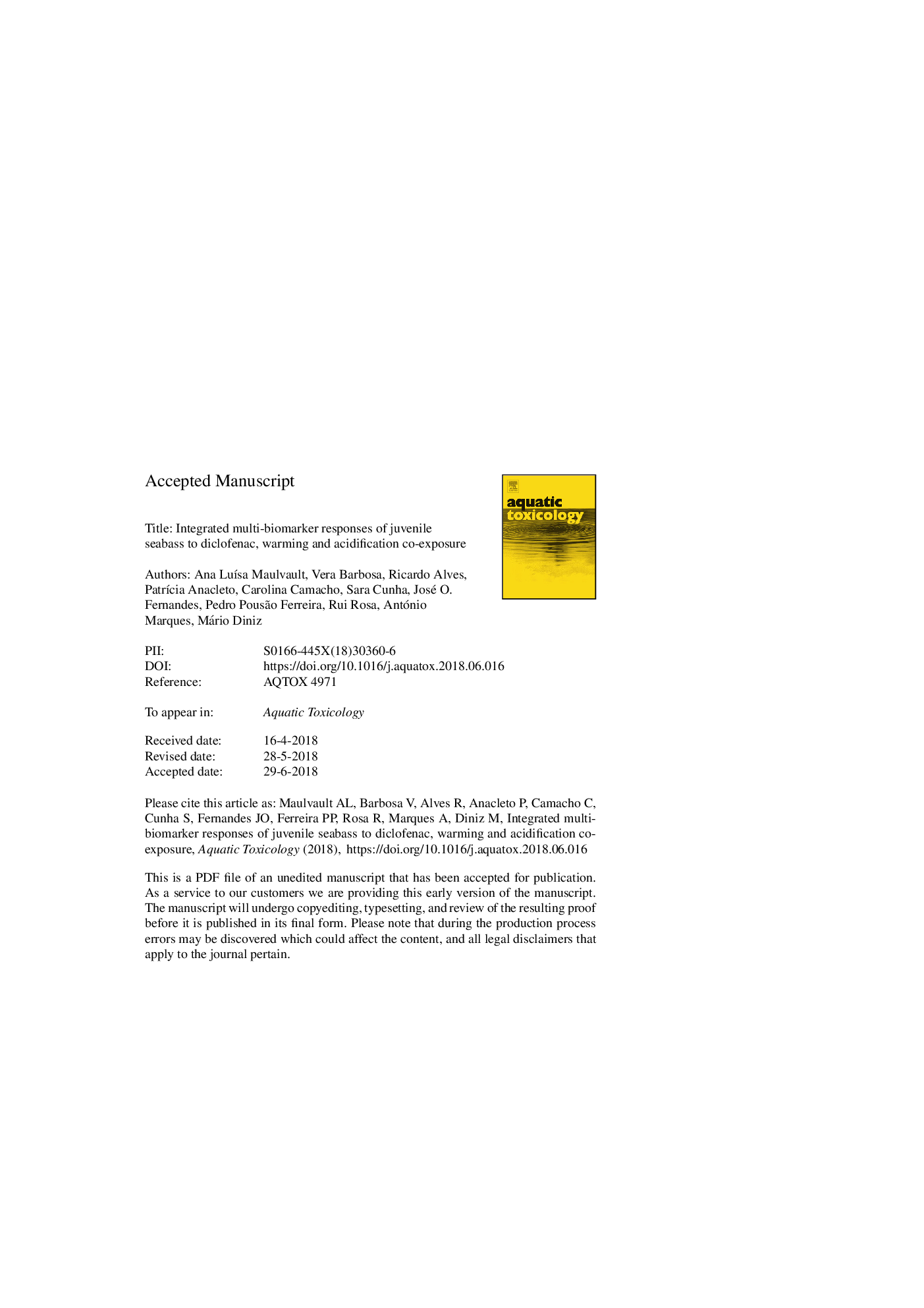| کد مقاله | کد نشریه | سال انتشار | مقاله انگلیسی | نسخه تمام متن |
|---|---|---|---|---|
| 8883642 | 1625903 | 2018 | 51 صفحه PDF | دانلود رایگان |
عنوان انگلیسی مقاله ISI
Integrated multi-biomarker responses of juvenile seabass to diclofenac, warming and acidification co-exposure
ترجمه فارسی عنوان
یکپارچه پاسخ های چند زیست شناسی ماهیان دریایی نوجوانان به دوکلوفناک، گرم شدن و همکاری با اسیدی
دانلود مقاله + سفارش ترجمه
دانلود مقاله ISI انگلیسی
رایگان برای ایرانیان
موضوعات مرتبط
علوم زیستی و بیوفناوری
علوم کشاورزی و بیولوژیک
علوم آبزیان
چکیده انگلیسی
Pharmaceutical drugs, such as diclofenac (DCF), are frequently detected in the marine environment, and recent evidence has pointed out their toxicity to non-target marine biota. Concomitantly, altered environmental conditions associated with climate change (e.g. warming and acidification) can also affect the physiology of marine organisms. Yet, the underlying interactions between these environmental stressors (pharmaceutical exposure and climate change-related stressors) still require a deeper understanding. Comprehending the influence of abiotic variables on chemical contaminants' toxicological attributes provides a broader view of the ecological consequences of climate change. Hence, the aim of this study was to assess the ecotoxicological responses of juvenile seabass Dicenthrachus labrax under the co-exposure to DCF (from dietary sources, 500â¯Â±â¯36â¯ng kgâ1 dw), warming (ÎTºC = +5â¯Â°C) and acidification (ÎpCO2 â¼1000 μatm, equivalent to ÎpH = -0.4 units), using an “Integrated Biomarker Response” (IBR) approach. Fish were exposed to these three stressors, acting alone or combined, for 28 days in a full cross-factorial design, and blood, brain, liver and muscle tissues were subsequently collected in order to evaluate: i) animal/organ fitness; ii) hematological parameters and iii) molecular biomarkers. Results not only confirmed the toxicological attributes of dietary exposure to DCF in marine fish species at the tissue (e.g. lower HSI), cellular (e.g. increased ENAs and lower erythrocytes viability) and molecular levels (e.g. increased oxidative stress, protein degradation, AChE activity and VTG synthesis), but also showed that such attributes are altered by warming and acidification. Hence, while acidification and/or warming enhanced some effects of DCF exposure (e.g. by further lowering erythrocyte viability, and increasing brain GST activity and Ub synthesis in muscle), the co-exposure to these abiotic stressors also resulted in a reversion/inhibition of some molecular responses (e.g. lower CAT and SOD inhibition and VTG synthesis). IBRs evidenced that an overall higher degree of stress (i.e. high IBR index) was associated with DCF and warming co-exposure, while the effects of acidification were less evident. The distinct responses observed when DCF acted alone or the animals were co-exposed to the drug together with warming and acidification not only highlighted the relevance of considering the interactions between multiple environmental stressors in ecotoxicological studies, but also suggested that the toxicity of pharmaceuticals can be aggravated by climate change-related stressors (particularly warming), thus, posing additional biological challenges to marine fish populations.
ناشر
Database: Elsevier - ScienceDirect (ساینس دایرکت)
Journal: Aquatic Toxicology - Volume 202, September 2018, Pages 65-79
Journal: Aquatic Toxicology - Volume 202, September 2018, Pages 65-79
نویسندگان
Ana LuÃsa Maulvault, Vera Barbosa, Ricardo Alves, PatrÃcia Anacleto, Carolina Camacho, Sara Cunha, José O. Fernandes, Pedro Pousão Ferreira, Rui Rosa, António Marques, Mário Diniz,
